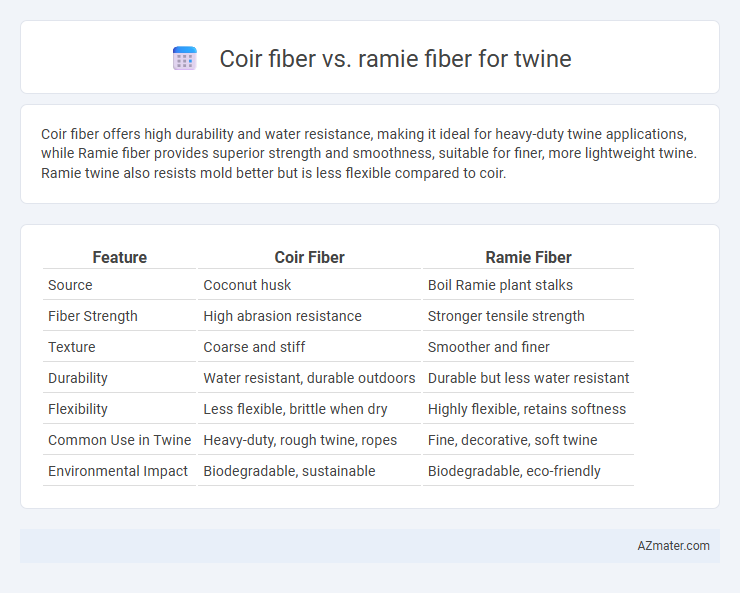Coir fiber offers high durability and water resistance, making it ideal for heavy-duty twine applications, while Ramie fiber provides superior strength and smoothness, suitable for finer, more lightweight twine. Ramie twine also resists mold better but is less flexible compared to coir.
Table of Comparison
| Feature | Coir Fiber | Ramie Fiber |
|---|---|---|
| Source | Coconut husk | Boil Ramie plant stalks |
| Fiber Strength | High abrasion resistance | Stronger tensile strength |
| Texture | Coarse and stiff | Smoother and finer |
| Durability | Water resistant, durable outdoors | Durable but less water resistant |
| Flexibility | Less flexible, brittle when dry | Highly flexible, retains softness |
| Common Use in Twine | Heavy-duty, rough twine, ropes | Fine, decorative, soft twine |
| Environmental Impact | Biodegradable, sustainable | Biodegradable, eco-friendly |
Introduction to Coir Fiber and Ramie Fiber
Coir fiber, derived from the outer husk of coconut shells, boasts robustness, water resistance, and durability, making it ideal for twine used in gardening, agriculture, and marine applications. Ramie fiber, obtained from the stalks of the Boehmeria plant, is known for its silky luster, high tensile strength, and resistance to bacteria, commonly used in textile and fine twine production. Comparing coir and ramie fibers involves evaluating their natural properties, environmental adaptability, and suitability for different twine applications.
Source and Extraction Methods
Coir fiber, derived from the outer husk of mature coconuts, is extracted through retting and mechanical decortication, yielding coarse and stiff fibers ideal for durable twine. Ramie fiber, sourced from the stalks of the Ramie plant (Boehmeria nivea), undergoes chemical or microbial degumming to remove gummy substances, producing fine, silky fibers suited for smooth and strong twine. The contrasting extraction processes and plant origins significantly influence the texture, strength, and application of twine made from coir and ramie fibers.
Physical Properties Comparison
Coir fiber, derived from coconut husks, is coarser and has higher tensile strength and durability, making it ideal for heavy-duty twine applications. Ramie fiber, sourced from the stalks of the ramie plant, is finer, smoother, and exhibits excellent lustre and tensile strength but is less coarse, resulting in twine that is softer and more flexible. Both fibers offer natural resistance to microbial attacks, with coir outperforming ramie in water resistance and abrasion durability essential for outdoor twine uses.
Mechanical Strength and Durability
Coir fiber exhibits superior mechanical strength with high tensile and impact resistance, making it highly durable for twine applications exposed to rough handling and moisture. Ramie fiber, while strong and smooth, offers excellent tensile strength but less elasticity and abrasion resistance compared to coir, reducing its durability in heavy-duty or outdoor uses. For twine requiring long-term resilience and mechanical robustness, coir fiber is generally preferred over ramie fiber.
Environmental Impact and Sustainability
Coir fiber, derived from coconut husks, is highly sustainable due to its renewable nature and ability to biodegrade quickly, reducing environmental footprint in twine production. Ramie fiber, sourced from the stalks of the Ramie plant, offers fast growth and low pesticide use, contributing to eco-friendly agriculture and reduced chemical pollution. Both fibers provide biodegradable alternatives to synthetic twine, but coir's utilization of agricultural waste and minimal processing energy gives it a slight edge in overall environmental impact.
Moisture Absorption and Resistance
Coir fiber exhibits high moisture absorption due to its coarse structure and natural lignin content, making it suitable for applications requiring water retention but prone to slower drying and susceptibility to microbial attack. Ramie fiber, characterized by low moisture regain around 12%, offers superior resistance to moisture and faster drying times, enhancing durability and resistance to mildew in twine products. The choice between coir and ramie fiber impacts twine performance in humid environments, with ramie providing better dimensional stability and coir offering cushioning and biodegradability.
Biodegradability and Decomposition Rate
Coir fiber, derived from coconut husks, offers excellent biodegradability with a decomposition rate typically ranging from 6 months to 2 years under natural conditions due to its high lignin content. Ramie fiber, extracted from the stalks of the Ramie plant, decomposes faster than coir because of its lower lignin and higher cellulose content, generally breaking down within 3 to 12 months. Both fibers are environmentally friendly choices for twine, but ramie's quicker decomposition makes it preferable for applications requiring faster biodegradation.
Cost and Market Availability
Coir fiber, derived from coconut husks, is cost-effective and widely available in tropical regions, making it a popular choice for twine production due to its durability and natural resistance to water. Ramie fiber, obtained from the stalks of the Chinese nettle plant, tends to be more expensive because of labor-intensive processing and limited cultivation areas, resulting in less market availability compared to coir. For manufacturers prioritizing affordability and large-scale sourcing, coir fiber presents a more viable option, whereas ramie fiber is preferred for specialized applications requiring finer texture and strength.
Applications in Twine Production
Coir fiber, derived from coconut husks, is widely used in twine production due to its natural resistance to saltwater, making it ideal for marine and agricultural applications. Ramie fiber, extracted from the stalks of the ramie plant, offers high tensile strength and a silky texture, making it suitable for decorative and lightweight twine products. Both fibers serve unique purposes: coir twine excels in durability and weather resistance, while ramie twine is preferred for fine, aesthetic uses.
Conclusion: Choosing Between Coir and Ramie for Twine
Coir fiber offers superior water resistance and durability, making it ideal for marine and outdoor twine applications. Ramie fiber provides a smoother texture and higher tensile strength, suitable for delicate crafts and lightweight twine products. Selecting between coir and ramie depends on the specific requirements for strength, texture, and environmental exposure in twine usage.

Infographic: Coir fiber vs Ramie fiber for Twine
 azmater.com
azmater.com